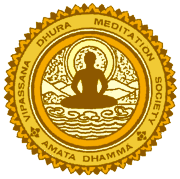How Long is a Moment?
In the practice of vipassana we try to stay in the present moment. Everyone knows what the present means: now. But what, precisely, is a moment? How long does it last? And when does the present moment become the past?
In vipassana the word moment has two senses: the first is what we might call the practice-moment. (Practice refers, of course, to meditation practice.) The second is the moment of consciousness itself.
Let's talk about the practice-moment first. In vipassana, a moment contains only one object of perception - one movement, sight, sound and so forth. It cannot contain both a sight and a sound; that would be two moments.
The length of the practice moment is determined by the object. For example, when we touch the toe to the floor in the walking exercise, that is one practice-moment; but it's shorter than the motion of moving the foot forward. Or sometimes the falling motion of the abdomen will be longer than the rising motion. A single practice-moment is about one to three seconds long. It means the length of time that a single object lasts as perceived by you, the observer. Or we could say it's the length of time that you focus on an object before letting it go and moving on to the next one. It can vary somewhat, being longer or shorter depending on the form we're observing.
When we take a step and then stop, we perceive that action as a single motion; it is one object, whose beginning and end we can see. In the basic walking exercise, the practice moment lasts the duration of a single step. But in the advanced walking practice, each step is divided into six smaller movements. Each one of these movements is an object. So each step contains six practice-moments.
As soon as we complete the step, that moment is over. It is now the past. If we are still thinking about it, that means we have let the mind stray away from the present. What is the present? Only the next object that arises. The practice moment can be something that arises naturally, as, for instance, the length of one abdominal movement; or it can be an object that we generate on purpose, such as a movement of the hand.
The moment of consciousness, on the other hand, refers to a moment of the mind arising and disappearing. The rate of this moment is incredibly fast, and it never changes. It is an ultimate phenomenon. One moment of consciousness is the smallest unit by which we can measure ultimate reality. A single one of these blips is thousands of times shorter than a 2-3 second practice moment. All consciousness moments are of the same length. And they're arising and disappearing all the time, whether or not we recognize them.
Now, it is possible for the meditator to go from observing the first kind of moment to seeing the second. As mindfulness gets sharper and faster, the student begins to bridge the gap between the practice moment and the moment of the mind. When this happens, the meditator might focus on one walking step, for example, and perceive several moments arise and pass away before the movement of the foot is finished. There might be a sense of great speed as mindfulness sees something in a split second, like a meteor streaking across the sky. The meditator may have the experience that, as soon as he focuses on anything, it bursts or disappears immediately. The moments become shorter and shorter as mindfulness is able to cut things faster and faster. When this occurs, the student is beginning to see the second kind of moment.
When mindfulness is fast enough, the student clearly experiences the moment of consciousness itself. He sees one mind-moment (citta), arising and vanishing in sharp detail. To see this is to see the actual truth of our experience, undistorted by delusion. It is to see ultimate reality. He then understands one of the three characteristics: impermanence, unsatisfactoriness, or impersonality. This is something to be understood by experience only, not by thinking it out.
So the aim of vipassana practice is to get mindfulness fast enough that it can perceive a single moment of consciousness arising and disappearing. One need only see three or four such moments in a row in order to reach enlightenment. Indeed, even perceiving one moment of consciousness is a great boon for the meditator, an experience, it's said, that will continue to give benefit for three successive lives.
This essay Copyright © 2006 by Cynthia Thatcher

